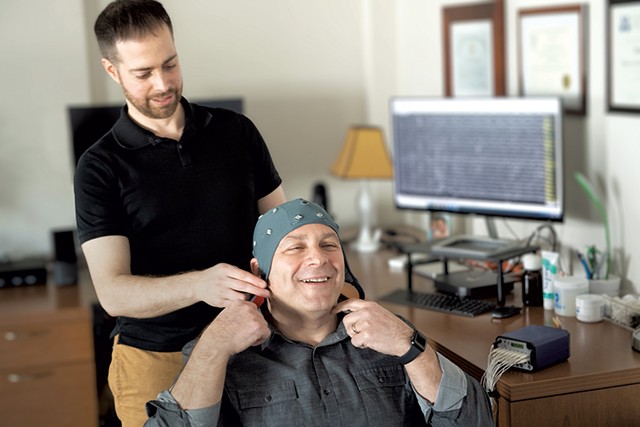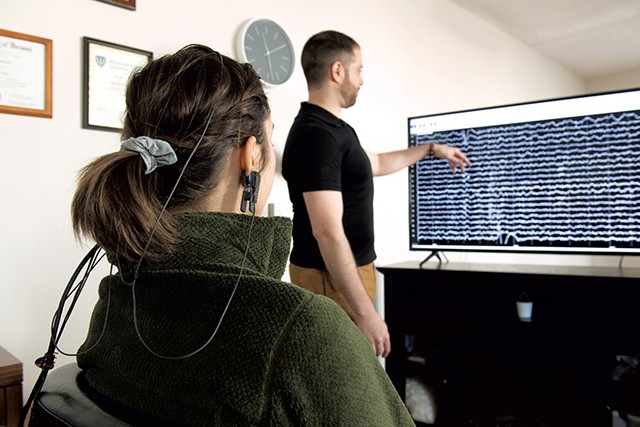
- Courtesy
- Dr. David Helfand (left) with a patient. The cap contains 19 electrodes that measure the brain's electrical activity.
When a 10-year romantic relationship ended last spring for “Joshua,” a young man living in the Boston area, he decided he needed professional help. He suspected there was a connection between the breakup and his powerful and at times crippling social anxiety.
"I'd freeze up and stutter, or glaze over and lose track of the conversation," he explained in an email interview with Seven Days. "Over many years, I began to just avoid people, which affected my ability to make friends and personal connections."
But Joshua, who described himself as "an extremely logical and methodical person who places great value on science, data and evidence-based practices," remembered a book he'd discovered years ago in his grandfather's library. Titled Biofeedback: Theory and Research and edited by Gary E. Schwartz and Jackson Beatty, it recounted how patients, hooked up to a heart monitor and lights, learned to modulate their heart rhythm using only their thoughts. So when Joshua's psychologist, David Helfand of St. Johnsbury, suggested he try a similar technique — neurofeedback — to address his social anxiety and relationship woes, Joshua approached it with an open mind.
Neurofeedback gives a patient a self-awareness of their brain's electrical activity, presented to them as visual, auditory or tactile feedback or cues. The patient then learns techniques to adjust certain brain waves associated with specific moods, emotions or psychological states.
Neurofeedback, which originated in the 1960s, has been used for years to treat chronic pain, headaches, seizures, post-traumatic stress disorder, attention deficit hyperactivity disorder and other conditions. It's now being applied in couples therapy to help romantic partners communicate more effectively and reduce the stress, friction and psychological triggers that often trip up marriages and committed relationships.
Research on the effectiveness of neurofeedback in couples counseling is limited. Nevertheless, many who've used it have found it helpful, especially in cases where other forms of therapy haven't worked, or when one or both partners have unresolved traumas in their past.
"Neurofeedback is like physical therapy for your brain," said Helfand, 37, who's been practicing neurofeedback in clinical settings since 2012 and using it in couples counseling since 2017.
Helfand explained how it works: If someone asks you to flex your bicep, you know immediately whether you're doing it correctly because you can see and feel the muscle flex.
"But if I tell you to increase your posterior alpha [activity] to soothe your nervous system, you have no idea what that feels like," he said.
However, if Helfand applies electrodes to a patient's scalp and measures their brain's electrical activity with an electroencephalogram, or EEG, the patient can see those brain waves represented in real time as a bar graph on a computer screen. (Other forms of neurofeedback use sounds or vibrations.) Helfand then teaches the patients techniques such as meditation, visualization and breathing exercises to dial those brain waves up or down into a more desirable range. Over time, as patients practice the techniques at home using their own software and headsets, they learn to recognize the feeling of being in a specific mental state, eventually replicating it without the use of equipment.
Helfand begins his couples counseling by creating a brain map of each partner. He uses a cap containing 19 electrodes that measure different brain waves in hertz, or cycles per second. The painless and noninvasive procedure, which costs $750, takes about an hour of the patient's time and several weeks for Helfand to analyze and formulate a treatment plan.
How does measuring brain waves enable partners to get back to a healthy and loving headspace?
Helfand often tells couples that his job is to help them release more endorphins and oxytocin — what he calls the "happy hormones." When relationships are falling apart, partners typically experience too many stress hormones — notably, cortisol and adrenaline. But often, the source of the problem isn't what the partners are saying to each other but how they're saying it — and receiving it.

- Courtesy
- Dr. David Helfand interpreting a brain map for a patient
Consider one couple Helfand treated recently. After mapping each partner's brain, he identified a potential bottleneck: One partner had what he called a very rapid "posterior dominant rhythm," which enables that partner to process information very quickly. Helfand likened their brain to "a high-end Porsche really zipping along," a trait he commonly sees among high-performing entrepreneurs and CEOs.
Meanwhile, the other partner's brain map revealed an auditory processing deficit, which slows their brain's ability to absorb verbal information.
"So, if I'm providing more information than you can process and consume, my judgment of you is probably, 'You don't care. You're not listening!"' Helfand said. "But in reality, the party receiving the info is just deluged with too much data and they can't process it."
In this case, Helfand recommended a low-tech solution: that the couple write each other letters. Doing so enabled the "Porsche brain" to voice emotions as quickly as they wanted, enabling the other partner to read and process those thoughts at their own pace.
Generally speaking, there are no absolute good or bad values when it comes to individual brain waves, Helfand said. Rather, he considers the ratios of certain brain waves to others. That said, certain electrical activity in the brain highly correlates with specific types of experiences, such as traumatic brain injuries and childhood abuse, which can reveal themselves through a brain map. Helfand likened it to a giant redwood that survives a forest fire and records it as a blemish in its rings.
"The same is true in our brains," Helfand said. "Your nervous system's only function is to keep you alive. It doesn't care about your relationships."
Barbara Colombo, a behavioral neuroscientist and professor of psychology at Champlain College, researches the use of neurofeedback in regulating emotions, reducing stress and increasing wellness. Though she hasn't studied its effectiveness in couples therapy, she said she "can see how you can use neurofeedback to retrain emotional responses during specific situations," such as when one partner is more apt to get angry or shut down.
So if a husband does something that reminds his wife of her abusive uncle, she may go into a fight, flight or freeze mode during their interactions. Or she may show signs of hypervigilance or difficulty relaxing.
In that case, Helfand can use neurofeedback to retrain both partners' emotional responses. The husband may need help in anger management. The wife may need to learn how to feel safe, resilient and strong when she's not facing an actual threat but is being triggered by past traumas.
To be clear, brain mapping and neurofeedback aren't mind reading. Helfand cannot spot inherent incompatibilities in personalities, such as when one partner wants children and the other doesn't. What brain mapping can reveal, and neurofeedback can address, he said, is a mismatch of individual skills.
Brain mapping can uncover all sorts of issues. Helfand can tell if a person is schizophrenic and having a dissociative episode, or if they're struggling with an undisclosed substance-abuse issue. As he told one patient during a session, "You look like you took a bong hit before you started this session." Flabbergasted, the patient asked how Helfand knew he was high.
"It's a very easy [brain] pattern to see," he replied.
Brain mapping can also reveal other physical ailments, such as undiagnosed TBIs and seizure conditions. In such cases, Helfand would refer the patient to a neurologist.
Helfand treated one couple in which the wife perceived her husband as depressed, lethargic and completely checked out of their marriage. They had trouble communicating, and their sex life was terrible. Then a brain map of the husband revealed the culprit.
"He had an encephalopathy. His brain looked like he was an NFL linebacker," Helfand recalled. Eventually, they discovered its cause: undiagnosed Lyme disease. Once he got treatment, Helfand said, "The marriage changed, because now he was joyful and positive and engaged."
As a patient once told Helfand, psychology is the only health care profession that doesn't routinely examine the affected organ. If a patient complains of chest pains, a doctor will listen to their heart. If a patient has trouble breathing, the doctor will measure their lung functions and perhaps order a chest X-ray.
"But in the field of psychology, we don't look at the organic function of the brain that often," Helfand said. "[Neurofeedback] really gives people a window into that."
In Joshua's case, Helfand used neurofeedback to help him dial down the brain waves associated with social anxiety. After undergoing two 15-minute sessions, Joshua said, he attended an event he'd been nervous about and found himself chatting with people he'd never met, telling stories, exchanging contact info "and generally fluttering about as the social butterfly I'd never been before."
On his way home, a friend remarked to Joshua how amazing it was to see him come out of his shell. Today, he describes himself as more in touch with his emotions. He's learned to stop overthinking things and feels better equipped to manage his anxiety.
"Any tool that allows us to pull back the curtain and peek behind the scenes of the brain ... and alter how we think on a subconscious level," he added, "truly has the power to change the world."










Comments
Comments are closed.
From 2014-2020, Seven Days allowed readers to comment on all stories posted on our website. While we've appreciated the suggestions and insights, right now Seven Days is prioritizing our core mission — producing high-quality, responsible local journalism — over moderating online debates between readers.
To criticize, correct or praise our reporting, please send us a letter to the editor or send us a tip. We’ll check it out and report the results.
Online comments may return when we have better tech tools for managing them. Thanks for reading.